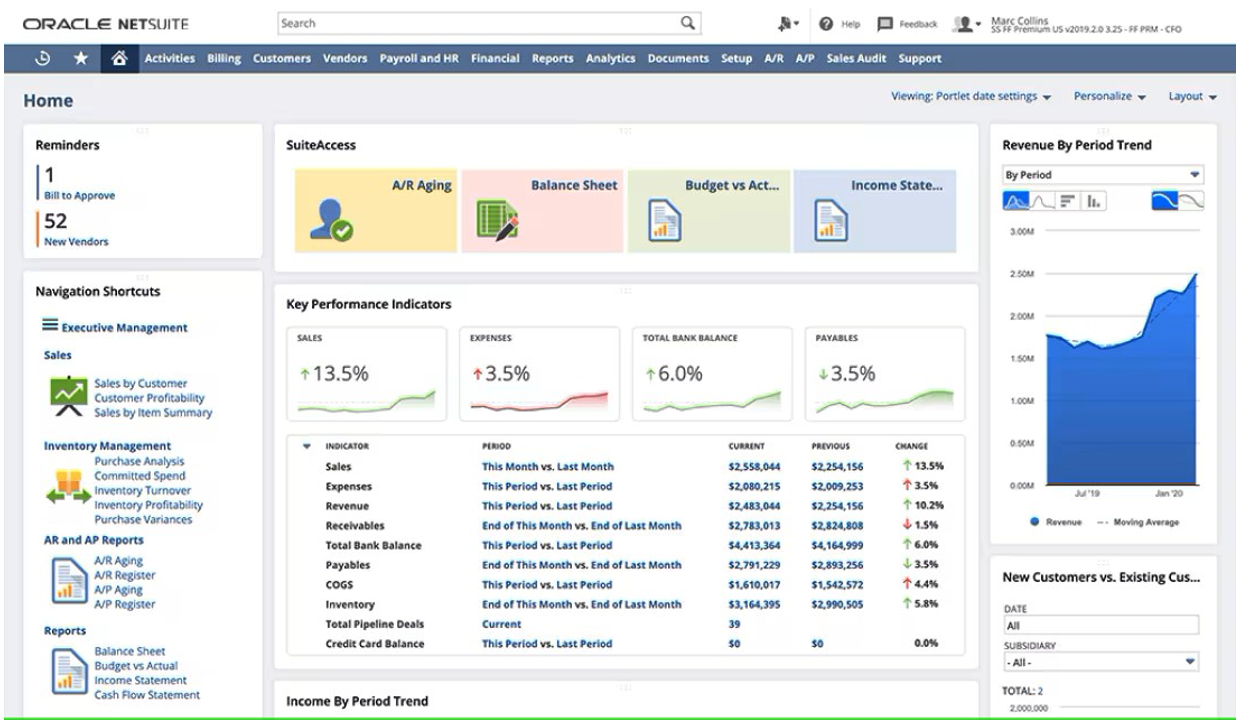Manufacturers face constant pressure to maintain quality as they meet ever more demanding customer expectations. Production schedules shift, raw-material costs fluctuate, and global supply chain disruptions threaten to slow or stop operations entirely. To overcome these obstacles, manufacturers need more than efficient machines and skilled workers—they need systems that can monitor the entire operation, collect raw data, and use that information to adapt and improve. Enterprise resource planning (ERP) systems help with that, but manufacturers must go a step further by tapping into industry-specific modules that optimize production. This article explores 13 essential manufacturing ERP modules that target the unique complexities and challenges today’s manufacturers confront.
What Is ERP for Manufacturing?
ERP systems for manufacturing are specialized business platforms companies use to integrate, automate, and oversee key steps in their manufacturing process. These systems often comprise multiple modules that work together within a unified system to improve operational efficiency, data accuracy, and decision-making. Each module addresses a specific manufacturing need—from procurement and production to inventory and finance—sharing data across the unified system to eliminate decision-making silos.
Though the core functionalities of manufacturing ERP systems are similar, businesses can add various modules to customize these tools to create a solution that aligns well with their industry requirements, budgetary restrictions, production methods, and business objectives. Additionally, many modern manufacturing ERP vendors offer cloud-based, on-premises, or hybrid solutions to give companies deployment flexibility.
Key Takeaways
- ERP systems for manufacturing integrate siloed departments into a unified platform, providing real-time visibility and control across production, inventory, and finance.
- Targeted ERP modules address specific manufacturing challenges by eliminating manual processes and enhancing operational efficiency.
- Successful ERP implementation starts with identifying existing needs and bottlenecks before selecting modules that address immediate objectives and support long-term growth.
Manufacturing ERP Explained
To successfully implement a manufacturing ERP system, a business must first carefully evaluate its current processes, bottlenecks, requirements, and goals to choose modules that best address its inherent challenges. This involves analyzing workflow inefficiencies, evaluating requirements for integration with existing systems that will remain after implementation, and considering scalability needs to ensure that the chosen solution provides long-term value.
After module selection, implementation can begin, starting with testing the core functions essential to daily operations, such as finance and inventory management, and then expanding to cover more specialized functions. This kind of phased approach allows manufacturers to build a strong foundation and establish staff buy-in while minimizing disruption to existing operations. As staff members become more proficient with the system, implementation teams can make adjustments as real results come in and integrate additional modules to further enhance processes and productivity.
Why Are Manufacturing ERP Modules Important?
According to Fictiv’s “2023 State of Manufacturing Report,” 55% of businesses listed improving manufacturing and supply chain visibility as their top priority. This was especially true among midsize businesses, with 63% of those respondents prioritizing visibility. Fortunately, by adding the right modules, manufacturers can incorporate specialized functionality into their ERP systems to increase visibility into production workflows, costs, and quality control. Such transparency allows managers and decision-makers to make production upgrades that respond to market changes. After making these adjustments, business leaders can use the same module capabilities to monitor the impact of changes over time and scale operations without sacrificing output quality or jeopardizing favorable customer experiences.
The modular nature of ERP systems for manufacturing also enables businesses to adapt quickly to changing regulatory requirements and customer demands. According to a recent study by the National Association of Manufacturers, U.S. manufacturers spend roughly $350 billion a year to comply with federal regulations. As manufacturers expand their operations or enter new markets, a flexible ERP system allows them to add new functions to address emerging challenges and changing regulations without having to overhaul their entire system. As a result, the long-term return on investment (ROI) of these systems increases, and companies can be sure they’ll have the tools they need to remain both competitive and compliant.
Essential ERP for Manufacturing Modules and Functions
Different modules work together to manage manufacturing functions within a centralized ERP system. Although specific attributes vary by vendor, industry, and business size, the following 13 modules have proven to be the most beneficial for manufacturers.
-
Inventory Management
Detailed inventory tracking gives manufacturers transparency into stock levels so they can effectively balance inventory reserves relative to carrying costs to meet demand without experiencing stockouts or overstocking. Inventory modules create a comprehensive view of inventory levels by providing real-time tracking data on raw materials, work-in-progress items, and finished goods across multiple locations, and it automatically highlights inventory discrepancies. By comparing this information against advanced forecasting data, manufacturers can assess changing demand patterns and automate reordering processes to minimize costs without impacting customer satisfaction.
-
Quality Management
Quality management modules help manufacturers meet product standards while following exact customer specifications and maintaining regulatory compliance. These modules also pinpoint inefficiencies and identify areas where managers can improve production quality. Common ERP quality control features include comprehensive quality testing, automatic defect flagging, ongoing lot tracking, and automated compliance documentation that can assist with audits. Catching issues early in the production process—before they reach customers—lets manufacturers create a reliable customer experience while reducing waste, rework, disruption, and recalls.
-
Manufacturing Execution System (MES)
MES modules bridge the gap between planning and production cycles through real-time monitoring and control of manufacturing operations. These systems track production progress, machine use, and worker productivity, and automatically collect and organize data for analysis and refinement. MES’s visibility allows manufacturers to set efficient and realistic production schedules and to respond quickly to unexpected changes or slowdowns.
-
Supply Chain Management
Supply chain management modules let manufacturers track the flow of supplies and goods from initial raw material sourcing to final product delivery. Beyond tracking physical orders, these systems also track key performance indicators (KPIs), such as supplier performance, lead times, and logistics costs that, in turn, inform strategies aimed at building a more reliable supply chain operation. These modules also help automate repetitive tasks, including generating purchase orders and delivery receipts, which minimizes errors and accelerates the movement of goods.
-
Warehouse Management
Warehouse management modules enhance storage, picking, and shipping operations by creating a more detailed view of floor layouts and inventory counts. These tools provide visibility through built-in features, such as automated barcode scanning, strategically selected picking routes, precise inventory locating, and real-time order updates. By leveraging these tools in tandem with integrated inventory systems, manufacturers can create highly productive warehouses that process orders faster without increasing overhead costs or burning out staff.
-
Materials Requirements Planning (MRP)
MRP modules calculate precise material needs based on production schedules and sales forecasts. Depending on the business’s preference, an MRP module either generates recommendations or automatically places orders according to lead times, expected needs, and current stock levels. This kind of proactive procurement approach minimizes the risk of production slowdowns arising from delayed orders or incorrect purchases. Accurate and regular purchasing processes also help manufacturers sustain positive supplier relationships, which often enables them to anticipate and plan for materials shortages.
-
Customer Relationship Management (CRM)
CRM modules integrate sales and customer service data into an ERP system to paint a more complete picture of customer behaviors and preferences. By tracking customer interactions and order history in conjunction with production data and service requests, manufacturers can boost customer satisfaction by offering better communication, faster response times, and more accurate delivery estimates. CRM modules also benefit customer service teams by providing faster and more complete information when they’re solving issues or following up with customers.
-
Planning and Scheduling
Production planning modules focus on balancing available resources with forecasted demand and delivery commitments. They compare expected production needs with capacity, labor, and material constraints and then use this analysis to create optimized production schedules that maximize output and minimize waste. Helpful in the initial planning phases, these modules also aid manufacturers when unexpected changes arise by using real-time data to generate actionable suggestions for scheduling adjustments. This helps manufacturers meet on-time delivery expectations, even during production slowdowns or supply chain disruptions. Sophisticated systems can also sync with sensors and Internet of Things devices to monitor equipment performance and inform proactive maintenance schedules, thereby reducing downtime and avoiding breakdowns.
-
Product Configuration
Product configuration modules let manufacturers offer customers more complex product variations and customization options without burdening the sales and production teams, which benefits both self-service customers and sales teams during the configuration and quoting process. These ERP modules guide users through a bevy of available options, automatically validating proposed configurations against engineering and manufacturing limitations and ensuring that orders with accurate specifications get sent to the shop floor. Furthermore, many configuration modules integrate with equipment software, such as 3D printers and assembly robots, to help hone exact specifications during production.
-
Order Management
Order management modules integrate sales, production, and shipping operations to create a more detailed view of every step in order fulfillment—from initial quote to final delivery. As orders move through this process, these ERP modules automatically update order status for both customers and employees, alerting relevant parties to any changes or potential delays. After orders are completed, order management modules run ongoing KPI analyses, such as for monitoring changes in average delivery time or success rates, to reveal inefficiencies and revise future delivery estimates.
-
Business Intelligence
Business intelligence modules turn raw manufacturing data into performance insights by identifying patterns across production, sales, operations, and any other KPIs the company prioritizes. Leaders can access this data and resulting analyses through customizable reports and real-time dashboards to easily spot trends and predict potential issues before they become major headaches. Advanced analytics capabilities can also model different scenarios, arming decision-makers with likely outcomes and mitigation steps before they execute strategic pivots.
-
Procurement
Manufacturers use procurement modules to track supplier performance, supervise contracts, follow compliance standards, and monitor pricing changes. And when supply levels run low, procurement modules can automatically generate purchase orders and process payments. This helps manufacturers find the right mix of supplier quality, reliability, and cost without slowing down the ordering process or straining vendor relationships. Within an ERP system, procurement modules are often integrated with inventory, production, quality control, and material planning functions to align purchases with needs and quality standards.
-
Finance
Finance modules centralize accounting, budgeting, and reporting to give manufacturers a complete view of their financial health. By using these modules to automate routine transactions and generate real-time financial reports as needed, manufacturers can monitor their profitability, costs, cash flow, and investments from one central location. Additionally, finance modules can automatically reconcile accounts and create a secure paper trail of all transactions, which is especially useful in demonstrating financial history for stakeholders or regulatory agencies.
How to Choose the Right Manufacturing ERP System
Selecting the best ERP solution goes beyond choosing modules from a checklist and should include consideration of indirect benefits, such as easy adoption for staff, seamless integration with existing systems, and support for the business’s long-term goals. Manufacturers can follow these five steps to navigate the selection process and configure an ERP system that provides the best chances of long-term success.
- Assess business requirements: Start by identifying the biggest operational pain points that a new ERP solution should address, such as inefficient inventory tracking, disconnected financials, or procurement bottlenecks. Then, map out how specific modules can solve these challenges and define the scope of the project so as to set expectations for both immediate improvements and long-term strategies.
- Assemble a taskforce: Create a team that includes representatives from key departments that will be impacted by the ERP implementation, such as production, finance, IT, inventory, and factory staff. A diverse team of managers and front-line workers can deliver new insights into daily operations and workflows, ensuring that potential selections will meet real-world needs and address root causes of inefficiencies.
- Identify industry-specific features: Narrow the field of potential ERP systems to those built to handle unique manufacturing-industry challenges, such as lot tracking, regulatory reporting, or complex production workflows. While some out-of-the-box features may be good fits, others may require extensive customization to afford long-term competitive advantages and maximize the ROI of the solution.
- Evaluate vendors: Assess each vendor’s manufacturing-industry experience and financial stability through market research, reviews, testimonials, and hands-on demonstrations. Pay special attention to their implementation support, user interface design, training programs, integration capabilities, and any other priorities laid out in your earlier planning phase.
- Consider what you need to scale: Choose a system that not only meets today’s needs but also can grow with the business as market conditions and customer expectations evolve. When assessing scalability, consider potential future requirements, such as adding additional production lines, facilities, or international capabilities. In general, cloud-based solutions offer more flexibility for growth than on-premises systems because vendors, rather than the manufacturer itself, maintain and update systems as new needs arise.
NetSuite ERP for Manufacturers Is Built for Growth
Manufacturers must navigate increasingly complex global supply chains and rising costs without sacrificing the high-quality output that keeps them competitive. NetSuite ERP for manufacturing is a fully integrated solution that connects production, inventory, procurement, supply chain, and financials under one solution. With customizable manufacturing-specific modules, businesses gain real-time and comprehensive data throughout the production process to track work orders, manage production scheduling, and improve shop floor efficiency.
NetSuite seamlessly connects with inventory features, such as accurate stock tracking and automated replenishment, as well as with supply chain management modules to provide end-to-end visibility that averts disruptions. NetSuite’s cloud-based platform is also scalable, which helps manufacturers keep up with changing industry regulations and growing production needs as they expand.
Scale Your Operation With NetSuite

As operations become more complex, a manufacturer’s systems must evolve for the business to remain competitive. ERP systems customized with manufacturing-focused modules empower companies to transform obstacles into growth opportunities by automating processes, connecting data, and providing real-time visibility across the production process. By customizing the right solution to fit their specific needs, manufacturers do more than solve today’s problems: They better position themselves to adapt to future challenges and ensure sustainable success.
Manufacturing ERP Modules FAQs
Which four major areas do ERP modules usually focus on?
Enterprise resource planning (ERP) systems for manufacturing typically focus on four primary operational areas: production management, supply chain operations, financial controls, and customer relationship management. These core targets integrate into a centralized ERP system, allowing manufacturers to connect critical business processes and create a holistic view of the manufacturing process from procurement to customer service. Each area will likely use specialized modules that reflect a manufacturer’s specific objectives.
What are the major functional modules of ERP?
The essential modules of a manufacturing enterprise resource planning (ERP) system will vary based on a business’s goals and requirements, but they often include finance, inventory management, production planning, and supply chain management. Additional modules may include quality control, warehouse management, customer relationship management, and material requirements planning. Since not every manufacturer needs all modules, many companies initially prioritize core financial and production modules before adding more targeted functionalities that address specific operational needs or support targeted growth initiatives.









